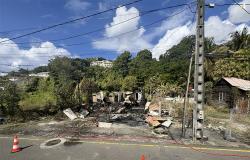As always with the disappearance of children, it only took a moment. On October 16, 1984 around 5:20 p.m., Grégory Villemin, 4 years old, disappeared from the pile of gravel on which he had been playing for less than fifteen minutes, in front of the family home in Lépanges-sur-Vologne, in the Vosges. The same evening, his body was found in Vologne.
In the age of film photos, which must be developed, of the landline telephone, and of the high mass of the 20 Hours to take the pulse of the world, it only takes 36 hours for the sweet and mischievous face of the little boy be propelled everywhere on the front page. The affair of little Grégory, two words which will now be systematically pronounced together by the whole of France, begins when he is found dead less than four hours after his disappearance, 7 km from Lépanges. His hands and feet were tied up, his cap was pushed over his head. An anonymous call to the little brother of Jean-Marie Villemin, the boy’s father, indicated to the gendarmes that the child had been thrown into the white waters of the Vologne. An anonymous letter, sent before or at the time of the kidnapping, gives revenge as the motive, a curious revenge that even today nothing seems to explain.
“Each twist crystallizes the interest”
These are three of the reasons which make Grégory’s affair “an exceptional affair in the face of other news items”, recognizes Lucie Jouvet-Legrand, lecturer at the University of Franche-Comté. “Like the Dominici affair, it remains in the annals for its many mysteries, and each twist and turn crystallizes interest. Like the Outreau affair, it is a case which questions the dysfunctions of judicial and media treatment.” But above all, according to the researcher, it is a tragedy that could have happened to any parent: “Who hasn’t let their child play outside for a quarter of an hour to finish their ironing,” asks the socioanthropologist. It’s trivial, everyday life, for anyone. The projection capital is enormous. Everyone can feel the pain that devastated Jean-Marie and Christine Villemin,” she believes.
“The phenomenon of empathy is enormous,” adds Martine Batt, professor of psychology at the University of Lorraine and legal expert. “The photo showed us a child as beautiful as anything, candid, helpless, we learned immediately that he had been tied up, as if to make him even more helpless. Everyone is sensitive to this vulnerability” and frightened by “human wickedness”. Grégory’s death is not an accident, “it is a planned, organized infanticide, for revenge. With the intention of killing to do harm,” she insists.
At the time, Martine Batt lived opposite the Metz prison where Christine Villemin, suspected of being the “crow”, was incarcerated. Six months pregnant, refusing to feed, she was released under judicial supervision. “People came to the prison, not only journalists who had invaded everything, but also anonymous people, moved, curious,” testifies the psychologist.
40 years after the events, this “crow” who has been poisoning the life of the Villemin family for months, is a key figure of fascination, because the alpha and omega of the Grégory affair. Despite the extent of studies and graphological comparisons, we still know nothing about him, or them, nor about his motivations, real or supposed. We could barely understand that he or she was angry with Jean-Marie Villemin for having attained the status of foreman in a factory in the country, allowing him to consider the construction of a new house on the heights of the village, yet furnished on credit. He talks about his “money” but that may just be an illusion. The incomprehension remains, a little voyeurism too, on the part of the followers of “web sleuthing”.
“I love this business”
In Lépanges, there are countless visitors to the cemetery looking for their graves. Grégory is no longer there, his parents had his remains exhumed a long time ago; they fall back on the church’s guest book. The notebook is full of references to the “little angel” who left “unjustly”. “I drove two hours to see you because I love this business,” childish writing even engraved in the recent pages, according to a photo taken Tuesday by an AFP photographer.
On discussion forums or under YouTube videos dedicated to the case, everyone has their own comment, analyzing the timing, the crow’s words, the intonations in the sound recordings, etc. An X account of “reflections on the Grégory affair” has nearly 4,000 subscribers; the Facebook group “Grégory Villemin August 24, 1980-October 16, 1984”, created in October 2013, still has more than 15,100 members. Some continue to accuse Christine of having thrown her son into the river, to hide a domestic accident or an affair. Others believe that Murielle Bolle, Bernard Laroche’s sister-in-law, holds, if not the answer, at least part of the secret.
On the other hand, many of them understand that Grégory’s father, mad with grief and convinced of the guilt of his cousin Bernard Laroche, in search of a confession, went to kill him five months after the death of his son. Laroche’s death is the only one that gave rise to a trial. Because for the rest, “there is no confirmed judicial truth. That leaves room for a lot of speculation,” notes Lucie Jouvet-Legrand.
“This story has no end”
This trial, in December 1993, which led to Jean-Marie Villemin being sentenced to four years in prison for the murder of Bernard Laroche, is the anchor point of the first volume of the comic strip “Grégory”, written in collaboration with Jean-Marie Villemin and published on October 3 by Les Arènes, a “friendly” house of the Villemin couple. “This trial is the only time where all the protagonists in the case are gathered in the same place,” explains their publisher, Laurent Muller.
Curiosity, for him, “comes from the fact that history has no end. Jean-Marie and Christine would dream of it but each film, each TV film, each trace of DNA which allows the investigations to be relaunched, also rekindles general attention. Even the deaths of people who could have said what they knew. It doesn’t just come from the generations who experienced the affair, says the publisher: the Netflix documentary, released at the end of 2019, touched young people who were not born in 1984. 3,000 copies of the album, according to Laurent Muller, have been sold in bookstores since its release.






